Analysis and Evaluation of Enterprise Information Systems Architecture
VerifiedAdded on 2022/12/23
|10
|2288
|57
Report
AI Summary
This report provides an in-depth analysis and evaluation of Enterprise Information Systems Architecture (EISA). It examines the architecture from various perspectives, including its documentation procedures and future implications, referencing peer-reviewed articles. The report focuses on the usability of EIS, particularly in Research Administration Systems (RAS), and critically reviews different concepts from multiple sources. It highlights the significance of non-functional requirements (NFRs) such as integration, extensibility, performance, and reliability. The research methodology involves secondary data collection, with an emphasis on the importance of both probabilistic and non-probabilistic sampling methods for maintaining data reliability. The findings underscore the impact of EIS on business integration, management systems, and software tools. The report also addresses the issues of insufficient documentation, practical challenges of NFR, and concludes with the importance of codification in pattern analysis and the evaluation of EISA. The report is based on the provided IEEE article and aims to evaluate the selection process of EISA based on the needs of the business.
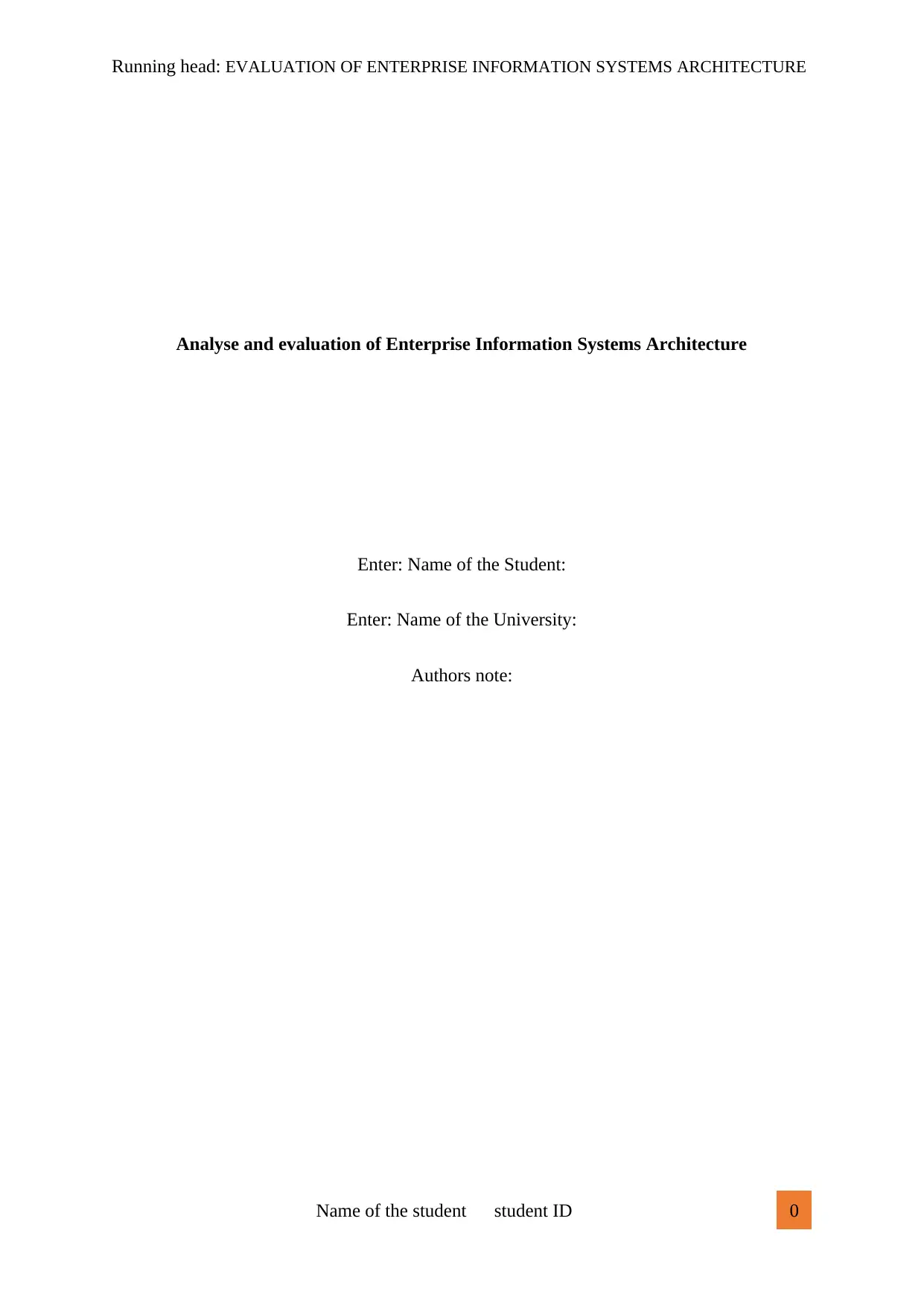
Running head: EVALUATION OF ENTERPRISE INFORMATION SYSTEMS ARCHITECTURE
Analyse and evaluation of Enterprise Information Systems Architecture
Enter: Name of the Student:
Enter: Name of the University:
Authors note:
Name of the student student ID 0
Analyse and evaluation of Enterprise Information Systems Architecture
Enter: Name of the Student:
Enter: Name of the University:
Authors note:
Name of the student student ID 0
Paraphrase This Document
Need a fresh take? Get an instant paraphrase of this document with our AI Paraphraser
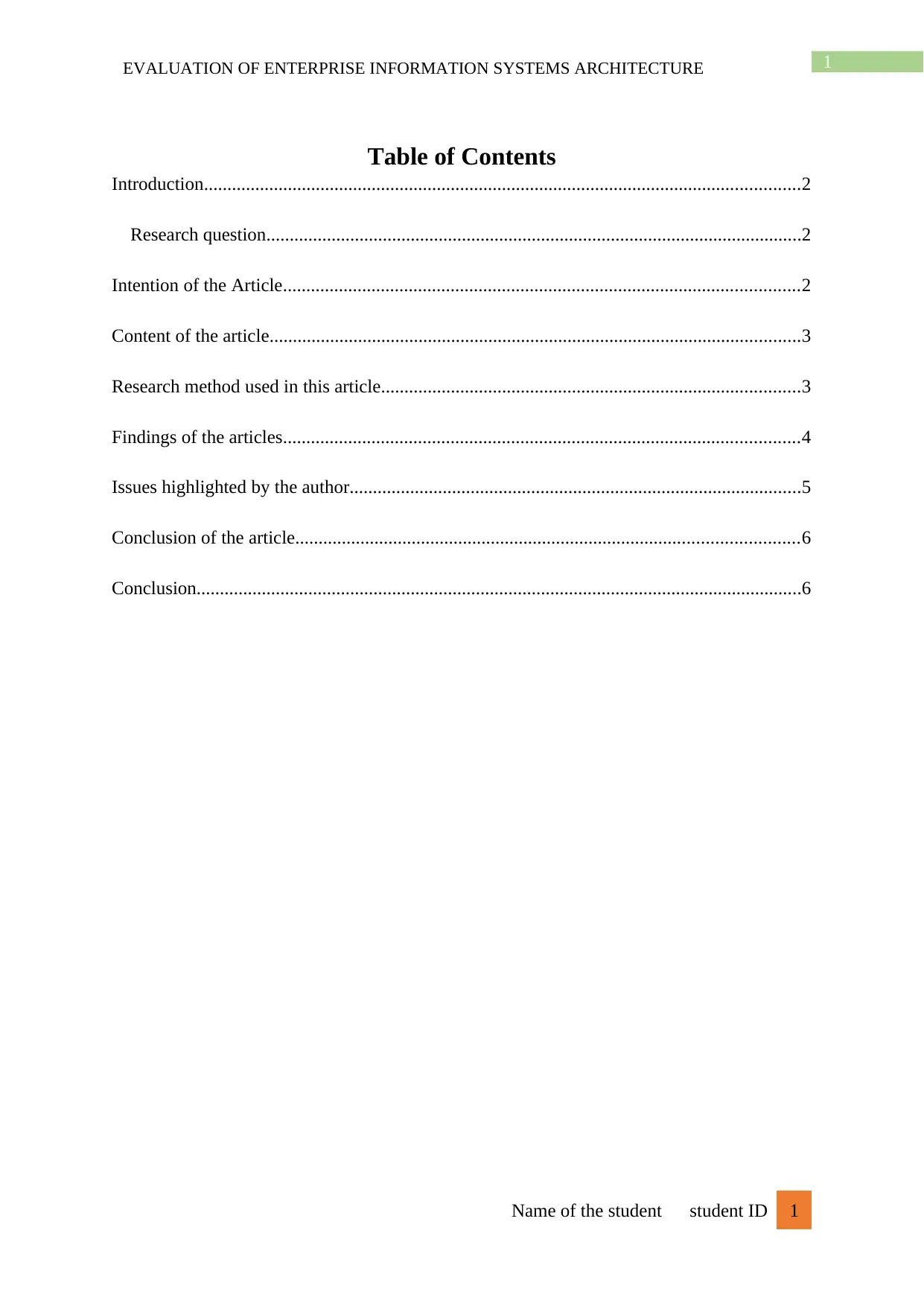
1EVALUATION OF ENTERPRISE INFORMATION SYSTEMS ARCHITECTURE
Table of Contents
Introduction................................................................................................................................2
Research question...................................................................................................................2
Intention of the Article...............................................................................................................2
Content of the article..................................................................................................................3
Research method used in this article..........................................................................................3
Findings of the articles...............................................................................................................4
Issues highlighted by the author.................................................................................................5
Conclusion of the article............................................................................................................6
Conclusion..................................................................................................................................6
Name of the student student ID 1
Table of Contents
Introduction................................................................................................................................2
Research question...................................................................................................................2
Intention of the Article...............................................................................................................2
Content of the article..................................................................................................................3
Research method used in this article..........................................................................................3
Findings of the articles...............................................................................................................4
Issues highlighted by the author.................................................................................................5
Conclusion of the article............................................................................................................6
Conclusion..................................................................................................................................6
Name of the student student ID 1
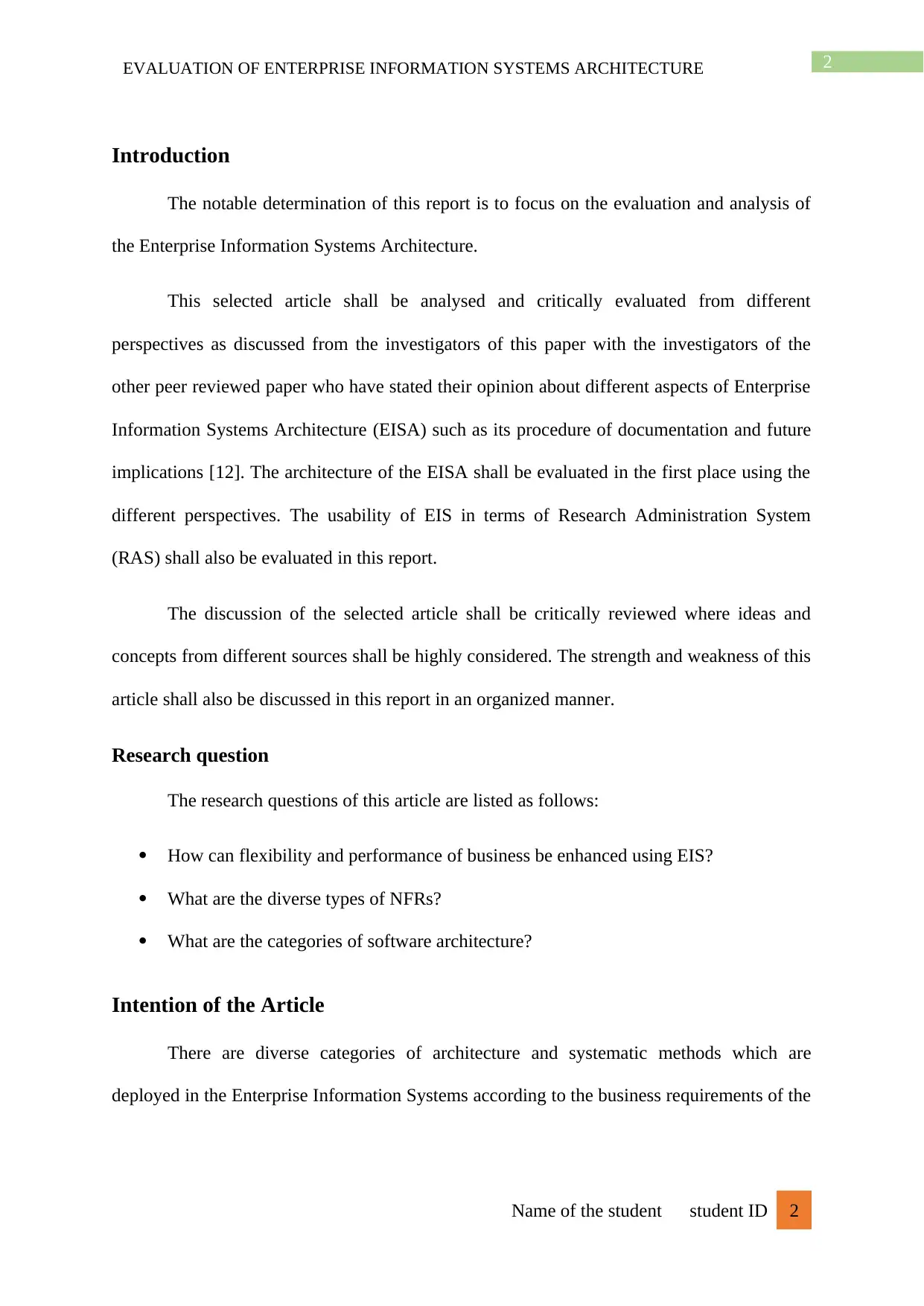
2EVALUATION OF ENTERPRISE INFORMATION SYSTEMS ARCHITECTURE
Introduction
The notable determination of this report is to focus on the evaluation and analysis of
the Enterprise Information Systems Architecture.
This selected article shall be analysed and critically evaluated from different
perspectives as discussed from the investigators of this paper with the investigators of the
other peer reviewed paper who have stated their opinion about different aspects of Enterprise
Information Systems Architecture (EISA) such as its procedure of documentation and future
implications [12]. The architecture of the EISA shall be evaluated in the first place using the
different perspectives. The usability of EIS in terms of Research Administration System
(RAS) shall also be evaluated in this report.
The discussion of the selected article shall be critically reviewed where ideas and
concepts from different sources shall be highly considered. The strength and weakness of this
article shall also be discussed in this report in an organized manner.
Research question
The research questions of this article are listed as follows:
How can flexibility and performance of business be enhanced using EIS?
What are the diverse types of NFRs?
What are the categories of software architecture?
Intention of the Article
There are diverse categories of architecture and systematic methods which are
deployed in the Enterprise Information Systems according to the business requirements of the
Name of the student student ID 2
Introduction
The notable determination of this report is to focus on the evaluation and analysis of
the Enterprise Information Systems Architecture.
This selected article shall be analysed and critically evaluated from different
perspectives as discussed from the investigators of this paper with the investigators of the
other peer reviewed paper who have stated their opinion about different aspects of Enterprise
Information Systems Architecture (EISA) such as its procedure of documentation and future
implications [12]. The architecture of the EISA shall be evaluated in the first place using the
different perspectives. The usability of EIS in terms of Research Administration System
(RAS) shall also be evaluated in this report.
The discussion of the selected article shall be critically reviewed where ideas and
concepts from different sources shall be highly considered. The strength and weakness of this
article shall also be discussed in this report in an organized manner.
Research question
The research questions of this article are listed as follows:
How can flexibility and performance of business be enhanced using EIS?
What are the diverse types of NFRs?
What are the categories of software architecture?
Intention of the Article
There are diverse categories of architecture and systematic methods which are
deployed in the Enterprise Information Systems according to the business requirements of the
Name of the student student ID 2
⊘ This is a preview!⊘
Do you want full access?
Subscribe today to unlock all pages.

Trusted by 1+ million students worldwide
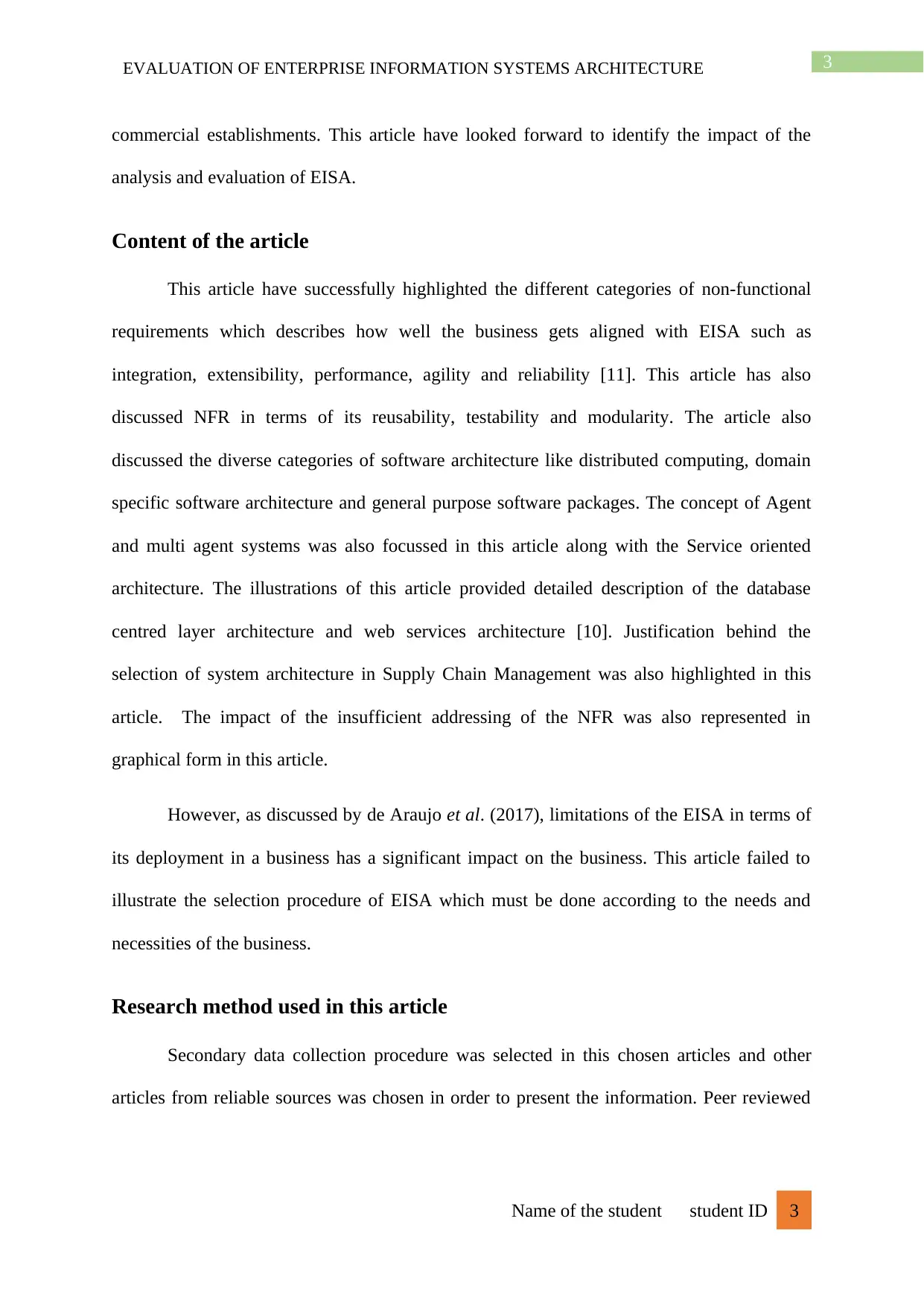
3EVALUATION OF ENTERPRISE INFORMATION SYSTEMS ARCHITECTURE
commercial establishments. This article have looked forward to identify the impact of the
analysis and evaluation of EISA.
Content of the article
This article have successfully highlighted the different categories of non-functional
requirements which describes how well the business gets aligned with EISA such as
integration, extensibility, performance, agility and reliability [11]. This article has also
discussed NFR in terms of its reusability, testability and modularity. The article also
discussed the diverse categories of software architecture like distributed computing, domain
specific software architecture and general purpose software packages. The concept of Agent
and multi agent systems was also focussed in this article along with the Service oriented
architecture. The illustrations of this article provided detailed description of the database
centred layer architecture and web services architecture [10]. Justification behind the
selection of system architecture in Supply Chain Management was also highlighted in this
article. The impact of the insufficient addressing of the NFR was also represented in
graphical form in this article.
However, as discussed by de Araujo et al. (2017), limitations of the EISA in terms of
its deployment in a business has a significant impact on the business. This article failed to
illustrate the selection procedure of EISA which must be done according to the needs and
necessities of the business.
Research method used in this article
Secondary data collection procedure was selected in this chosen articles and other
articles from reliable sources was chosen in order to present the information. Peer reviewed
Name of the student student ID 3
commercial establishments. This article have looked forward to identify the impact of the
analysis and evaluation of EISA.
Content of the article
This article have successfully highlighted the different categories of non-functional
requirements which describes how well the business gets aligned with EISA such as
integration, extensibility, performance, agility and reliability [11]. This article has also
discussed NFR in terms of its reusability, testability and modularity. The article also
discussed the diverse categories of software architecture like distributed computing, domain
specific software architecture and general purpose software packages. The concept of Agent
and multi agent systems was also focussed in this article along with the Service oriented
architecture. The illustrations of this article provided detailed description of the database
centred layer architecture and web services architecture [10]. Justification behind the
selection of system architecture in Supply Chain Management was also highlighted in this
article. The impact of the insufficient addressing of the NFR was also represented in
graphical form in this article.
However, as discussed by de Araujo et al. (2017), limitations of the EISA in terms of
its deployment in a business has a significant impact on the business. This article failed to
illustrate the selection procedure of EISA which must be done according to the needs and
necessities of the business.
Research method used in this article
Secondary data collection procedure was selected in this chosen articles and other
articles from reliable sources was chosen in order to present the information. Peer reviewed
Name of the student student ID 3
Paraphrase This Document
Need a fresh take? Get an instant paraphrase of this document with our AI Paraphraser
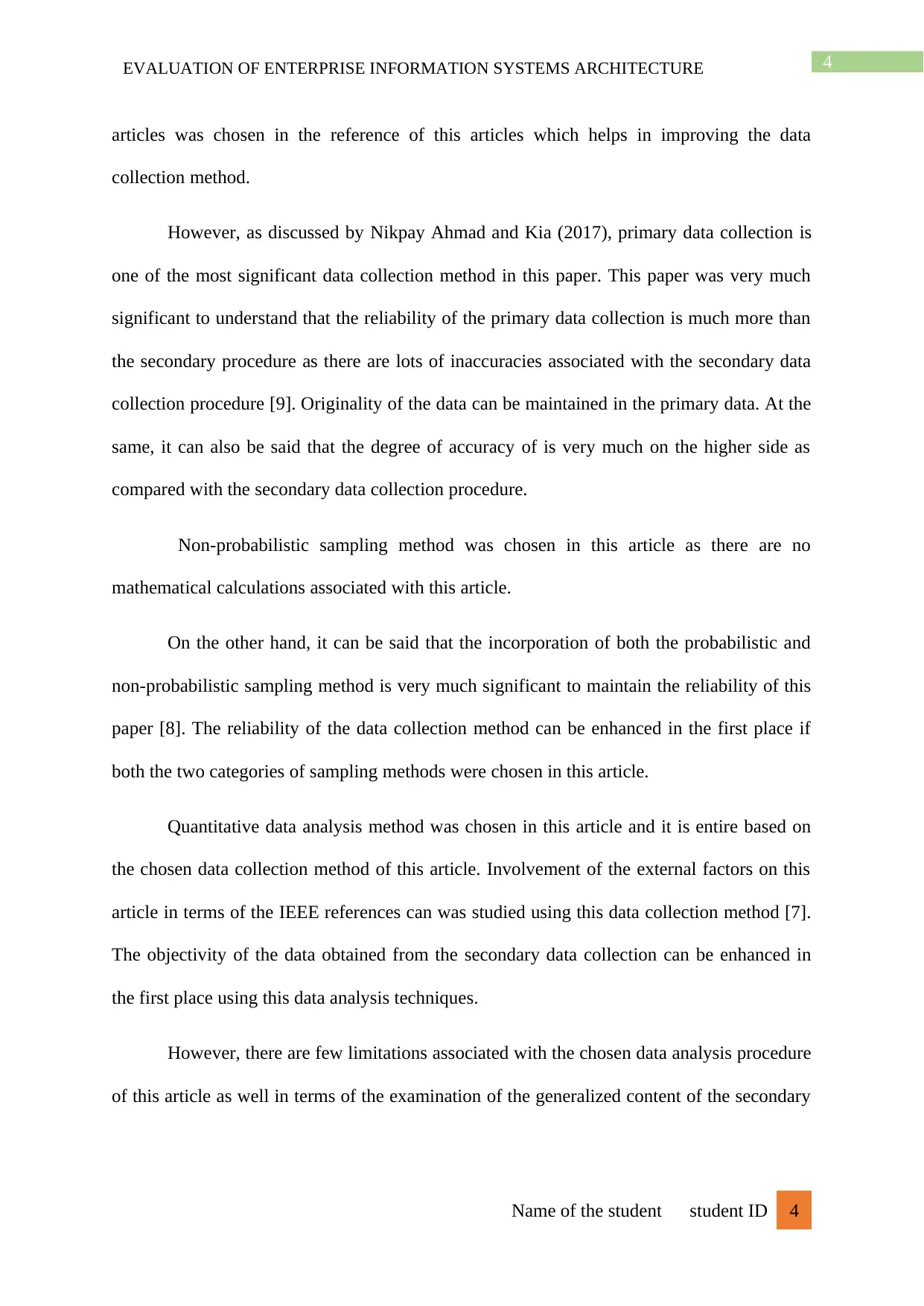
4EVALUATION OF ENTERPRISE INFORMATION SYSTEMS ARCHITECTURE
articles was chosen in the reference of this articles which helps in improving the data
collection method.
However, as discussed by Nikpay Ahmad and Kia (2017), primary data collection is
one of the most significant data collection method in this paper. This paper was very much
significant to understand that the reliability of the primary data collection is much more than
the secondary procedure as there are lots of inaccuracies associated with the secondary data
collection procedure [9]. Originality of the data can be maintained in the primary data. At the
same, it can also be said that the degree of accuracy of is very much on the higher side as
compared with the secondary data collection procedure.
Non-probabilistic sampling method was chosen in this article as there are no
mathematical calculations associated with this article.
On the other hand, it can be said that the incorporation of both the probabilistic and
non-probabilistic sampling method is very much significant to maintain the reliability of this
paper [8]. The reliability of the data collection method can be enhanced in the first place if
both the two categories of sampling methods were chosen in this article.
Quantitative data analysis method was chosen in this article and it is entire based on
the chosen data collection method of this article. Involvement of the external factors on this
article in terms of the IEEE references can was studied using this data collection method [7].
The objectivity of the data obtained from the secondary data collection can be enhanced in
the first place using this data analysis techniques.
However, there are few limitations associated with the chosen data analysis procedure
of this article as well in terms of the examination of the generalized content of the secondary
Name of the student student ID 4
articles was chosen in the reference of this articles which helps in improving the data
collection method.
However, as discussed by Nikpay Ahmad and Kia (2017), primary data collection is
one of the most significant data collection method in this paper. This paper was very much
significant to understand that the reliability of the primary data collection is much more than
the secondary procedure as there are lots of inaccuracies associated with the secondary data
collection procedure [9]. Originality of the data can be maintained in the primary data. At the
same, it can also be said that the degree of accuracy of is very much on the higher side as
compared with the secondary data collection procedure.
Non-probabilistic sampling method was chosen in this article as there are no
mathematical calculations associated with this article.
On the other hand, it can be said that the incorporation of both the probabilistic and
non-probabilistic sampling method is very much significant to maintain the reliability of this
paper [8]. The reliability of the data collection method can be enhanced in the first place if
both the two categories of sampling methods were chosen in this article.
Quantitative data analysis method was chosen in this article and it is entire based on
the chosen data collection method of this article. Involvement of the external factors on this
article in terms of the IEEE references can was studied using this data collection method [7].
The objectivity of the data obtained from the secondary data collection can be enhanced in
the first place using this data analysis techniques.
However, there are few limitations associated with the chosen data analysis procedure
of this article as well in terms of the examination of the generalized content of the secondary
Name of the student student ID 4
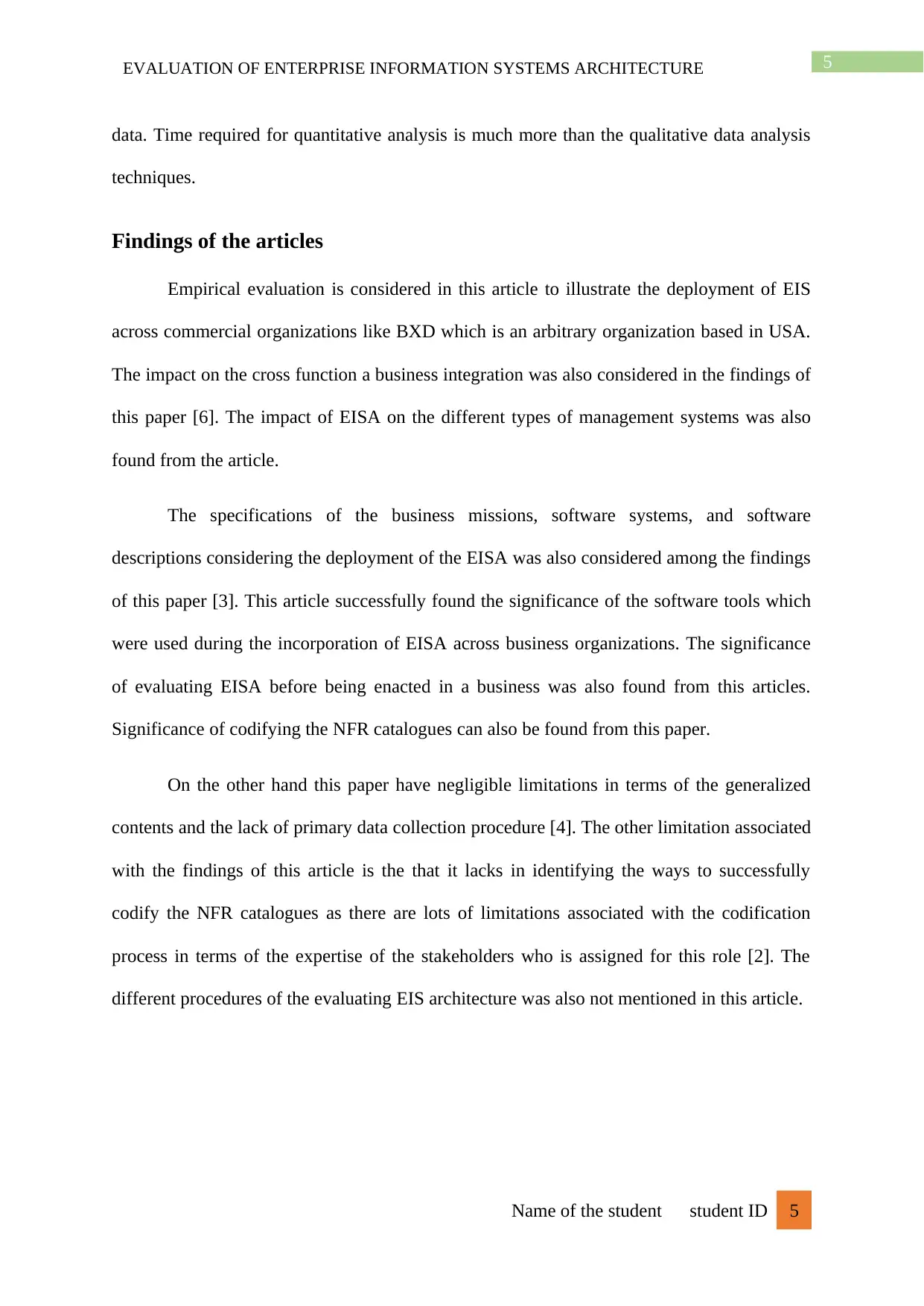
5EVALUATION OF ENTERPRISE INFORMATION SYSTEMS ARCHITECTURE
data. Time required for quantitative analysis is much more than the qualitative data analysis
techniques.
Findings of the articles
Empirical evaluation is considered in this article to illustrate the deployment of EIS
across commercial organizations like BXD which is an arbitrary organization based in USA.
The impact on the cross function a business integration was also considered in the findings of
this paper [6]. The impact of EISA on the different types of management systems was also
found from the article.
The specifications of the business missions, software systems, and software
descriptions considering the deployment of the EISA was also considered among the findings
of this paper [3]. This article successfully found the significance of the software tools which
were used during the incorporation of EISA across business organizations. The significance
of evaluating EISA before being enacted in a business was also found from this articles.
Significance of codifying the NFR catalogues can also be found from this paper.
On the other hand this paper have negligible limitations in terms of the generalized
contents and the lack of primary data collection procedure [4]. The other limitation associated
with the findings of this article is the that it lacks in identifying the ways to successfully
codify the NFR catalogues as there are lots of limitations associated with the codification
process in terms of the expertise of the stakeholders who is assigned for this role [2]. The
different procedures of the evaluating EIS architecture was also not mentioned in this article.
Name of the student student ID 5
data. Time required for quantitative analysis is much more than the qualitative data analysis
techniques.
Findings of the articles
Empirical evaluation is considered in this article to illustrate the deployment of EIS
across commercial organizations like BXD which is an arbitrary organization based in USA.
The impact on the cross function a business integration was also considered in the findings of
this paper [6]. The impact of EISA on the different types of management systems was also
found from the article.
The specifications of the business missions, software systems, and software
descriptions considering the deployment of the EISA was also considered among the findings
of this paper [3]. This article successfully found the significance of the software tools which
were used during the incorporation of EISA across business organizations. The significance
of evaluating EISA before being enacted in a business was also found from this articles.
Significance of codifying the NFR catalogues can also be found from this paper.
On the other hand this paper have negligible limitations in terms of the generalized
contents and the lack of primary data collection procedure [4]. The other limitation associated
with the findings of this article is the that it lacks in identifying the ways to successfully
codify the NFR catalogues as there are lots of limitations associated with the codification
process in terms of the expertise of the stakeholders who is assigned for this role [2]. The
different procedures of the evaluating EIS architecture was also not mentioned in this article.
Name of the student student ID 5
⊘ This is a preview!⊘
Do you want full access?
Subscribe today to unlock all pages.

Trusted by 1+ million students worldwide
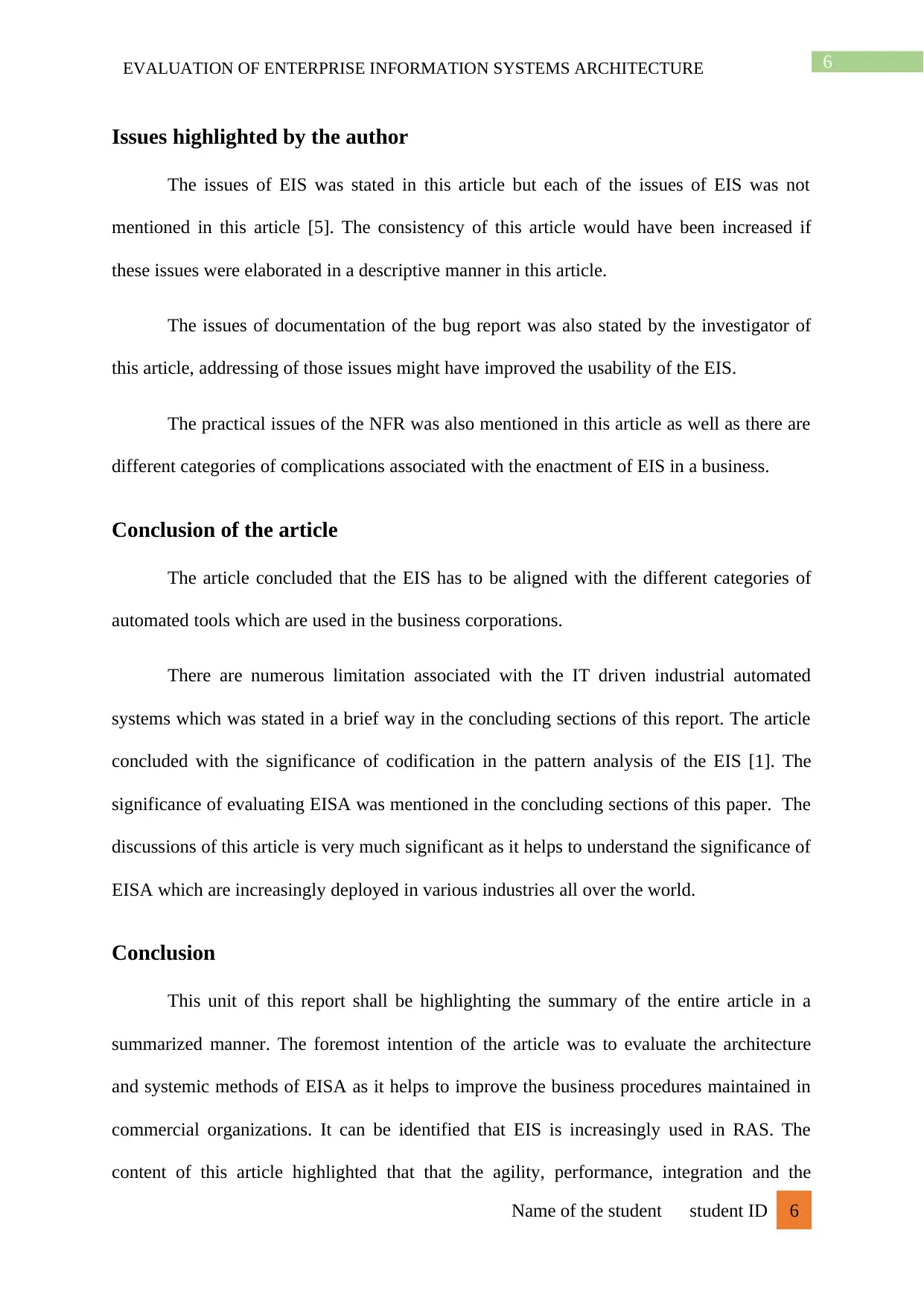
6EVALUATION OF ENTERPRISE INFORMATION SYSTEMS ARCHITECTURE
Issues highlighted by the author
The issues of EIS was stated in this article but each of the issues of EIS was not
mentioned in this article [5]. The consistency of this article would have been increased if
these issues were elaborated in a descriptive manner in this article.
The issues of documentation of the bug report was also stated by the investigator of
this article, addressing of those issues might have improved the usability of the EIS.
The practical issues of the NFR was also mentioned in this article as well as there are
different categories of complications associated with the enactment of EIS in a business.
Conclusion of the article
The article concluded that the EIS has to be aligned with the different categories of
automated tools which are used in the business corporations.
There are numerous limitation associated with the IT driven industrial automated
systems which was stated in a brief way in the concluding sections of this report. The article
concluded with the significance of codification in the pattern analysis of the EIS [1]. The
significance of evaluating EISA was mentioned in the concluding sections of this paper. The
discussions of this article is very much significant as it helps to understand the significance of
EISA which are increasingly deployed in various industries all over the world.
Conclusion
This unit of this report shall be highlighting the summary of the entire article in a
summarized manner. The foremost intention of the article was to evaluate the architecture
and systemic methods of EISA as it helps to improve the business procedures maintained in
commercial organizations. It can be identified that EIS is increasingly used in RAS. The
content of this article highlighted that that the agility, performance, integration and the
Name of the student student ID 6
Issues highlighted by the author
The issues of EIS was stated in this article but each of the issues of EIS was not
mentioned in this article [5]. The consistency of this article would have been increased if
these issues were elaborated in a descriptive manner in this article.
The issues of documentation of the bug report was also stated by the investigator of
this article, addressing of those issues might have improved the usability of the EIS.
The practical issues of the NFR was also mentioned in this article as well as there are
different categories of complications associated with the enactment of EIS in a business.
Conclusion of the article
The article concluded that the EIS has to be aligned with the different categories of
automated tools which are used in the business corporations.
There are numerous limitation associated with the IT driven industrial automated
systems which was stated in a brief way in the concluding sections of this report. The article
concluded with the significance of codification in the pattern analysis of the EIS [1]. The
significance of evaluating EISA was mentioned in the concluding sections of this paper. The
discussions of this article is very much significant as it helps to understand the significance of
EISA which are increasingly deployed in various industries all over the world.
Conclusion
This unit of this report shall be highlighting the summary of the entire article in a
summarized manner. The foremost intention of the article was to evaluate the architecture
and systemic methods of EISA as it helps to improve the business procedures maintained in
commercial organizations. It can be identified that EIS is increasingly used in RAS. The
content of this article highlighted that that the agility, performance, integration and the
Name of the student student ID 6
Paraphrase This Document
Need a fresh take? Get an instant paraphrase of this document with our AI Paraphraser
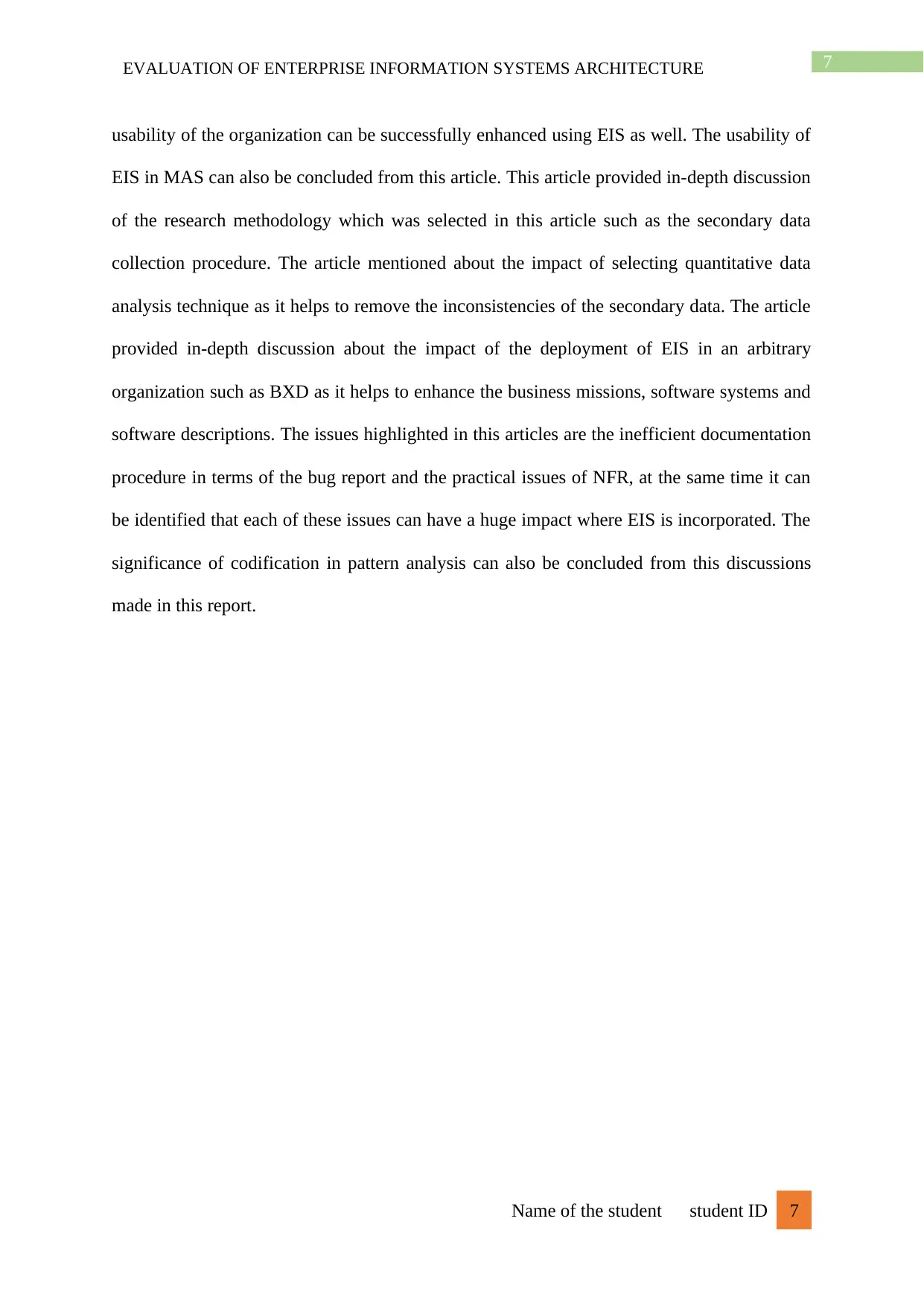
7EVALUATION OF ENTERPRISE INFORMATION SYSTEMS ARCHITECTURE
usability of the organization can be successfully enhanced using EIS as well. The usability of
EIS in MAS can also be concluded from this article. This article provided in-depth discussion
of the research methodology which was selected in this article such as the secondary data
collection procedure. The article mentioned about the impact of selecting quantitative data
analysis technique as it helps to remove the inconsistencies of the secondary data. The article
provided in-depth discussion about the impact of the deployment of EIS in an arbitrary
organization such as BXD as it helps to enhance the business missions, software systems and
software descriptions. The issues highlighted in this articles are the inefficient documentation
procedure in terms of the bug report and the practical issues of NFR, at the same time it can
be identified that each of these issues can have a huge impact where EIS is incorporated. The
significance of codification in pattern analysis can also be concluded from this discussions
made in this report.
Name of the student student ID 7
usability of the organization can be successfully enhanced using EIS as well. The usability of
EIS in MAS can also be concluded from this article. This article provided in-depth discussion
of the research methodology which was selected in this article such as the secondary data
collection procedure. The article mentioned about the impact of selecting quantitative data
analysis technique as it helps to remove the inconsistencies of the secondary data. The article
provided in-depth discussion about the impact of the deployment of EIS in an arbitrary
organization such as BXD as it helps to enhance the business missions, software systems and
software descriptions. The issues highlighted in this articles are the inefficient documentation
procedure in terms of the bug report and the practical issues of NFR, at the same time it can
be identified that each of these issues can have a huge impact where EIS is incorporated. The
significance of codification in pattern analysis can also be concluded from this discussions
made in this report.
Name of the student student ID 7
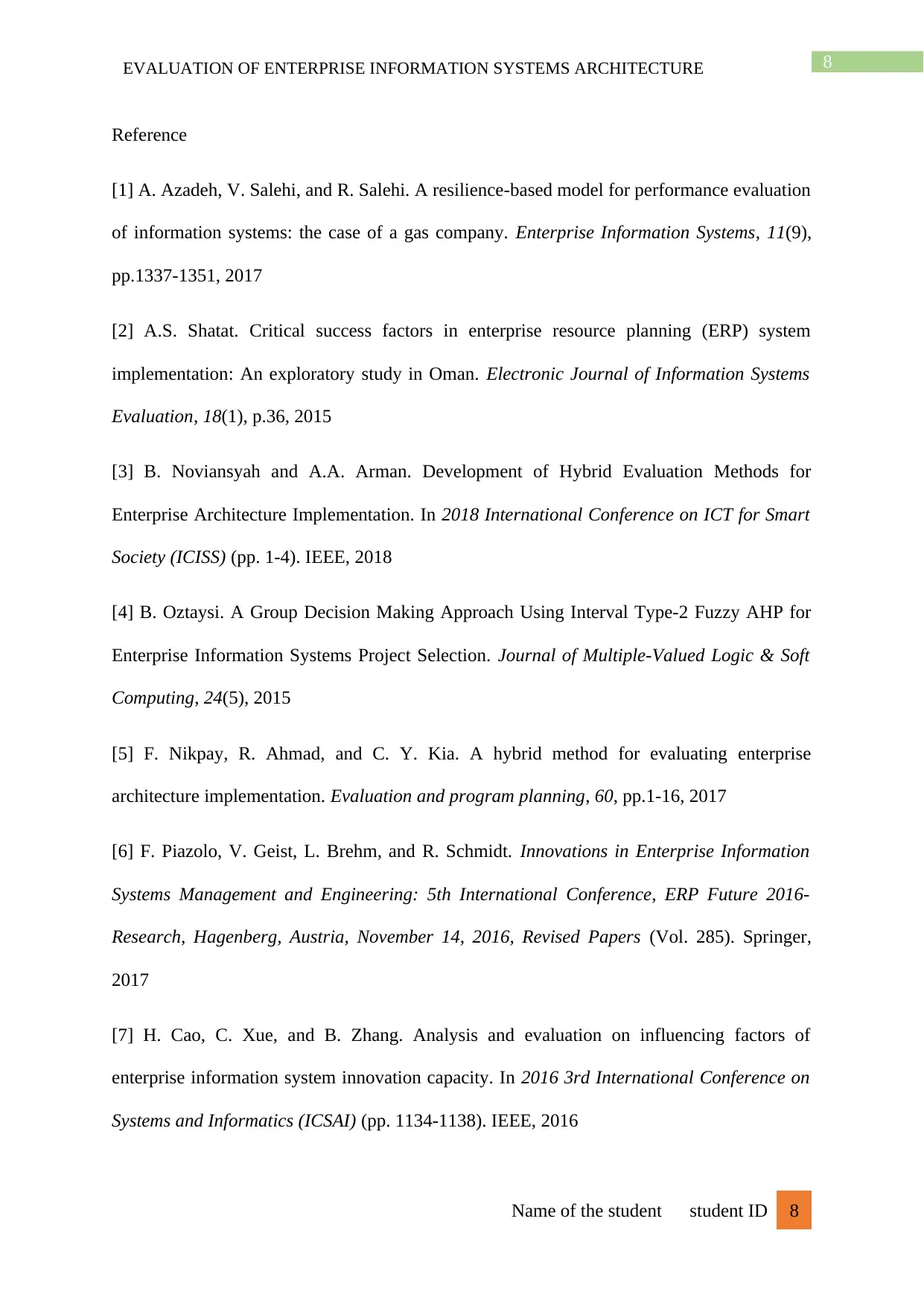
8EVALUATION OF ENTERPRISE INFORMATION SYSTEMS ARCHITECTURE
Reference
[1] A. Azadeh, V. Salehi, and R. Salehi. A resilience-based model for performance evaluation
of information systems: the case of a gas company. Enterprise Information Systems, 11(9),
pp.1337-1351, 2017
[2] A.S. Shatat. Critical success factors in enterprise resource planning (ERP) system
implementation: An exploratory study in Oman. Electronic Journal of Information Systems
Evaluation, 18(1), p.36, 2015
[3] B. Noviansyah and A.A. Arman. Development of Hybrid Evaluation Methods for
Enterprise Architecture Implementation. In 2018 International Conference on ICT for Smart
Society (ICISS) (pp. 1-4). IEEE, 2018
[4] B. Oztaysi. A Group Decision Making Approach Using Interval Type-2 Fuzzy AHP for
Enterprise Information Systems Project Selection. Journal of Multiple-Valued Logic & Soft
Computing, 24(5), 2015
[5] F. Nikpay, R. Ahmad, and C. Y. Kia. A hybrid method for evaluating enterprise
architecture implementation. Evaluation and program planning, 60, pp.1-16, 2017
[6] F. Piazolo, V. Geist, L. Brehm, and R. Schmidt. Innovations in Enterprise Information
Systems Management and Engineering: 5th International Conference, ERP Future 2016-
Research, Hagenberg, Austria, November 14, 2016, Revised Papers (Vol. 285). Springer,
2017
[7] H. Cao, C. Xue, and B. Zhang. Analysis and evaluation on influencing factors of
enterprise information system innovation capacity. In 2016 3rd International Conference on
Systems and Informatics (ICSAI) (pp. 1134-1138). IEEE, 2016
Name of the student student ID 8
Reference
[1] A. Azadeh, V. Salehi, and R. Salehi. A resilience-based model for performance evaluation
of information systems: the case of a gas company. Enterprise Information Systems, 11(9),
pp.1337-1351, 2017
[2] A.S. Shatat. Critical success factors in enterprise resource planning (ERP) system
implementation: An exploratory study in Oman. Electronic Journal of Information Systems
Evaluation, 18(1), p.36, 2015
[3] B. Noviansyah and A.A. Arman. Development of Hybrid Evaluation Methods for
Enterprise Architecture Implementation. In 2018 International Conference on ICT for Smart
Society (ICISS) (pp. 1-4). IEEE, 2018
[4] B. Oztaysi. A Group Decision Making Approach Using Interval Type-2 Fuzzy AHP for
Enterprise Information Systems Project Selection. Journal of Multiple-Valued Logic & Soft
Computing, 24(5), 2015
[5] F. Nikpay, R. Ahmad, and C. Y. Kia. A hybrid method for evaluating enterprise
architecture implementation. Evaluation and program planning, 60, pp.1-16, 2017
[6] F. Piazolo, V. Geist, L. Brehm, and R. Schmidt. Innovations in Enterprise Information
Systems Management and Engineering: 5th International Conference, ERP Future 2016-
Research, Hagenberg, Austria, November 14, 2016, Revised Papers (Vol. 285). Springer,
2017
[7] H. Cao, C. Xue, and B. Zhang. Analysis and evaluation on influencing factors of
enterprise information system innovation capacity. In 2016 3rd International Conference on
Systems and Informatics (ICSAI) (pp. 1134-1138). IEEE, 2016
Name of the student student ID 8
⊘ This is a preview!⊘
Do you want full access?
Subscribe today to unlock all pages.

Trusted by 1+ million students worldwide
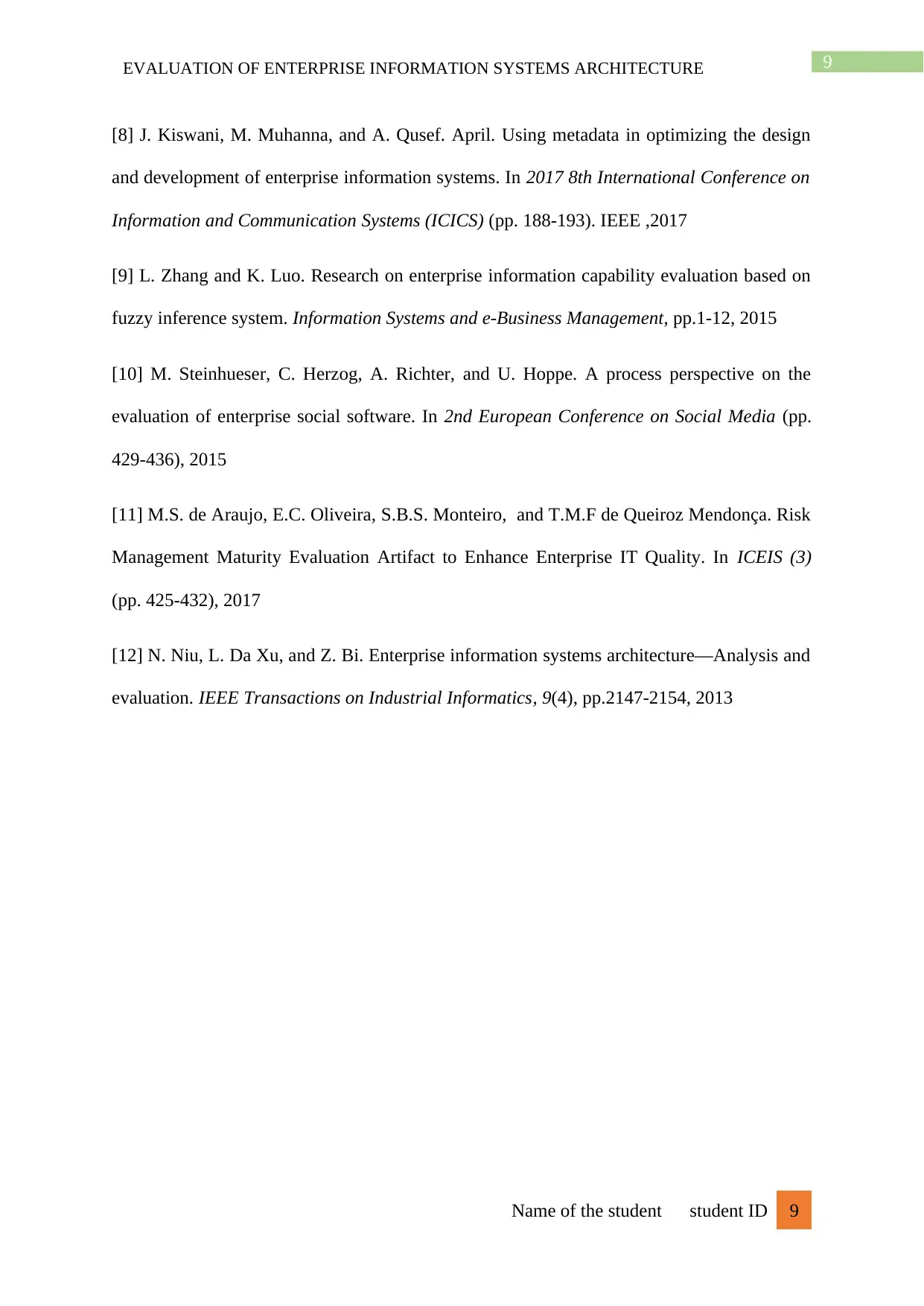
9EVALUATION OF ENTERPRISE INFORMATION SYSTEMS ARCHITECTURE
[8] J. Kiswani, M. Muhanna, and A. Qusef. April. Using metadata in optimizing the design
and development of enterprise information systems. In 2017 8th International Conference on
Information and Communication Systems (ICICS) (pp. 188-193). IEEE ,2017
[9] L. Zhang and K. Luo. Research on enterprise information capability evaluation based on
fuzzy inference system. Information Systems and e-Business Management, pp.1-12, 2015
[10] M. Steinhueser, C. Herzog, A. Richter, and U. Hoppe. A process perspective on the
evaluation of enterprise social software. In 2nd European Conference on Social Media (pp.
429-436), 2015
[11] M.S. de Araujo, E.C. Oliveira, S.B.S. Monteiro, and T.M.F de Queiroz Mendonça. Risk
Management Maturity Evaluation Artifact to Enhance Enterprise IT Quality. In ICEIS (3)
(pp. 425-432), 2017
[12] N. Niu, L. Da Xu, and Z. Bi. Enterprise information systems architecture—Analysis and
evaluation. IEEE Transactions on Industrial Informatics, 9(4), pp.2147-2154, 2013
Name of the student student ID 9
[8] J. Kiswani, M. Muhanna, and A. Qusef. April. Using metadata in optimizing the design
and development of enterprise information systems. In 2017 8th International Conference on
Information and Communication Systems (ICICS) (pp. 188-193). IEEE ,2017
[9] L. Zhang and K. Luo. Research on enterprise information capability evaluation based on
fuzzy inference system. Information Systems and e-Business Management, pp.1-12, 2015
[10] M. Steinhueser, C. Herzog, A. Richter, and U. Hoppe. A process perspective on the
evaluation of enterprise social software. In 2nd European Conference on Social Media (pp.
429-436), 2015
[11] M.S. de Araujo, E.C. Oliveira, S.B.S. Monteiro, and T.M.F de Queiroz Mendonça. Risk
Management Maturity Evaluation Artifact to Enhance Enterprise IT Quality. In ICEIS (3)
(pp. 425-432), 2017
[12] N. Niu, L. Da Xu, and Z. Bi. Enterprise information systems architecture—Analysis and
evaluation. IEEE Transactions on Industrial Informatics, 9(4), pp.2147-2154, 2013
Name of the student student ID 9
1 out of 10
Related Documents
Your All-in-One AI-Powered Toolkit for Academic Success.
+13062052269
info@desklib.com
Available 24*7 on WhatsApp / Email
![[object Object]](/_next/static/media/star-bottom.7253800d.svg)
Unlock your academic potential
Copyright © 2020–2025 A2Z Services. All Rights Reserved. Developed and managed by ZUCOL.





